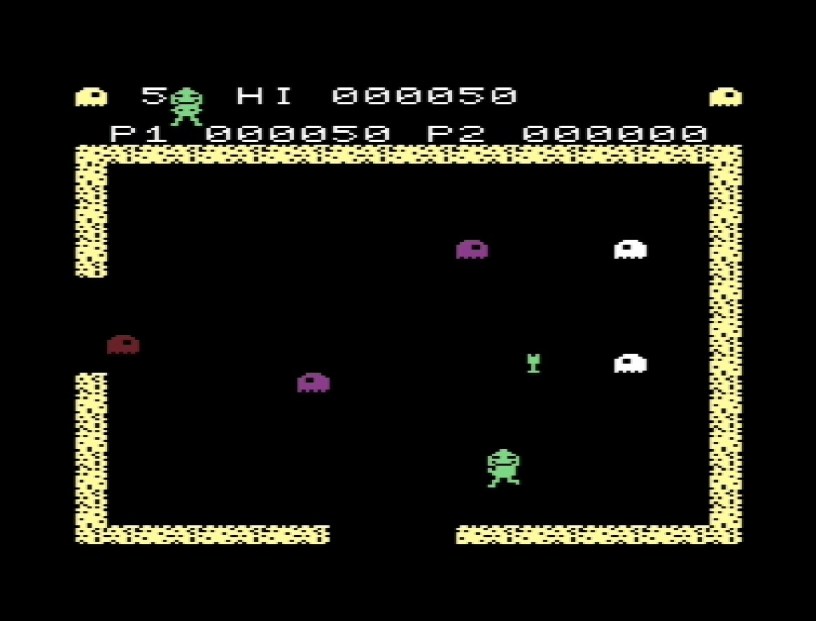My own collection of Computer & Video Games magazine began in April 1985, and apart from the following month’s issue, I didn’t miss one until well into the nineties when, in my early-twenties, my limited magazine budget had moved on to lads’ mags and the like. I was a month away from twelve when I started, although I had been reading a friend’s copy for over a year by then – looking back at older copies online, I can remember a couple from late 1983 so I guess I started around then. Anyway, back to my own ones, it wasn’t long ago that I realised I was missing that May 1985 copy from the huge pile of them that sit in reverse chronological on a shelf in my dressing-room (fancier than it sounds!), and after a little bit of patience on eBay it wasn’t long before I’d filled the gap at a reasonable price, by which I mean around a tenner versus the original 95p, which was actually an increase from 85p not long before, as we’re about to discover…
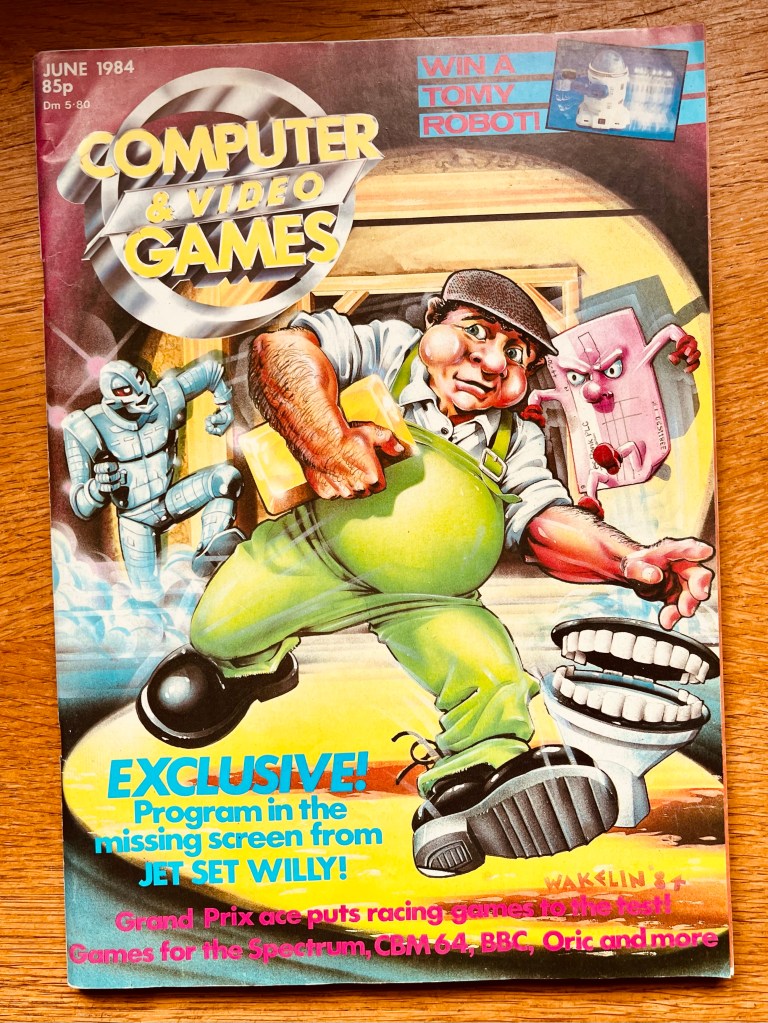
Inevitably, because I was now only three issues short, I then decided I might as well go back a few more months so I had a full set from 1985. And once that was done – equally inevitably – came 1984, which is where you find me now! It’s starting to get expensive though, and as much as I’m interested in going back through 1983 and as far as possible towards the first issues from 1982, it’s getting really expensive now! That reasonable price of £10 is closer to £15, and it then seems to rise exponentially the further back you go. Maybe I need to start looking forwards from the other end of my collection instead… Inevitable too! So far, though, I’m up to (or back to) June 1984, and that’s how we come upon the VIC-20 game I’ll eventually get to here, but first I just wanted to flick through the rest of the magazine for a while because as well as being a journey of discovery, it’s just such a time capsule!

To avoid me going on and on all day, I’ve pulled out a few highlights already to give you a flavour, and the first is the Software Top 30, in conjunction with The Daily Mirror newspaper, where it seems you’ll also find the brand new top ten in the Saturday edition every week! I think this is really fascinating, and included in the countdown is previous position, overall weeks in the chart, and a guide for what formats the game comes on – Spectrum, VIC-20, C64, Electron, Atari, Dragon, Oric, BBC and Other. That said, it was a depressing sign of things to come for the VIC-20 owner with only Jet-Pac representing the system this month. Incredible game though! Something else I noticed here was that I recognised every single game listed here, while – as we’ll see – there’s always loads of very highly-rated games in these early issues that were never heard of again, and as reliant as we were on these magazine scores to decide where our limited pocket money was going, it looks like the cream rose to the top regardless. This month the cream was Jet-Set Willy, and rightly so, but the rest all reads like an 8-bit hall of fame, with Manic Miner, Atic Atac, Scuba Dive, Hunchback, Pole Position, The Hobbit and the aforementioned Jet-Pac all listed, to name just a few.
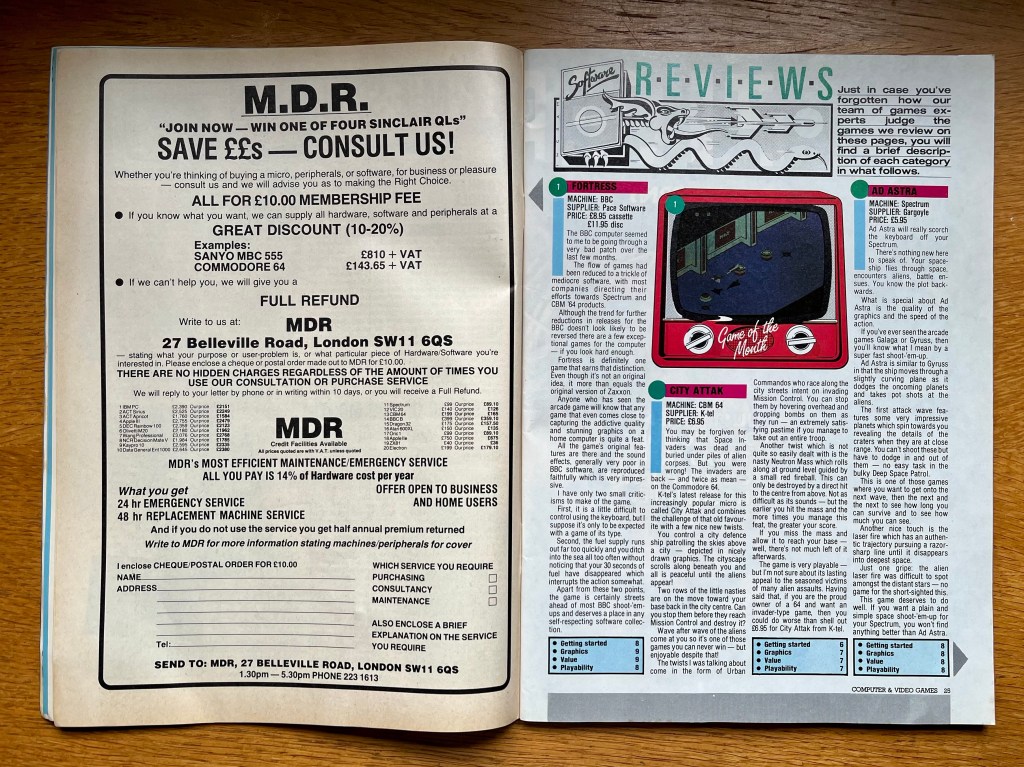
I’ll switch to the first of those big-scoring games I’ve never heard of next, although in its defence it was for the BBC so not surprising, and that’s the first of two Games of the Month, Fortress. The review system here isn’t quite what it would soon after become for the rest of the eighties, with “getting started” in the place of sound, as well as the regular graphics, value and playability. I did laugh because while this one does score eight out of ten for getting started, the only reference I can see to getting started is a complaint about how hard it is to control using the keyboard! According to this review, the VIC-20 isn’t the only machine seeing decent new titles becoming more scarce, but Fortress is an impressive feat in both BBC graphics and sound (not that you’d know that from the review scores!) even if it is just a Zaxxon rip-off! At this point in proceedings I’ll often say I might come back and look at this in more detail sometime, and add it to my big list of stuff to cover here, but I don’t really like Zaxxon, and I’ve already done Desert Falcon, so maybe we’ll have more luck with Game of the Month number two…
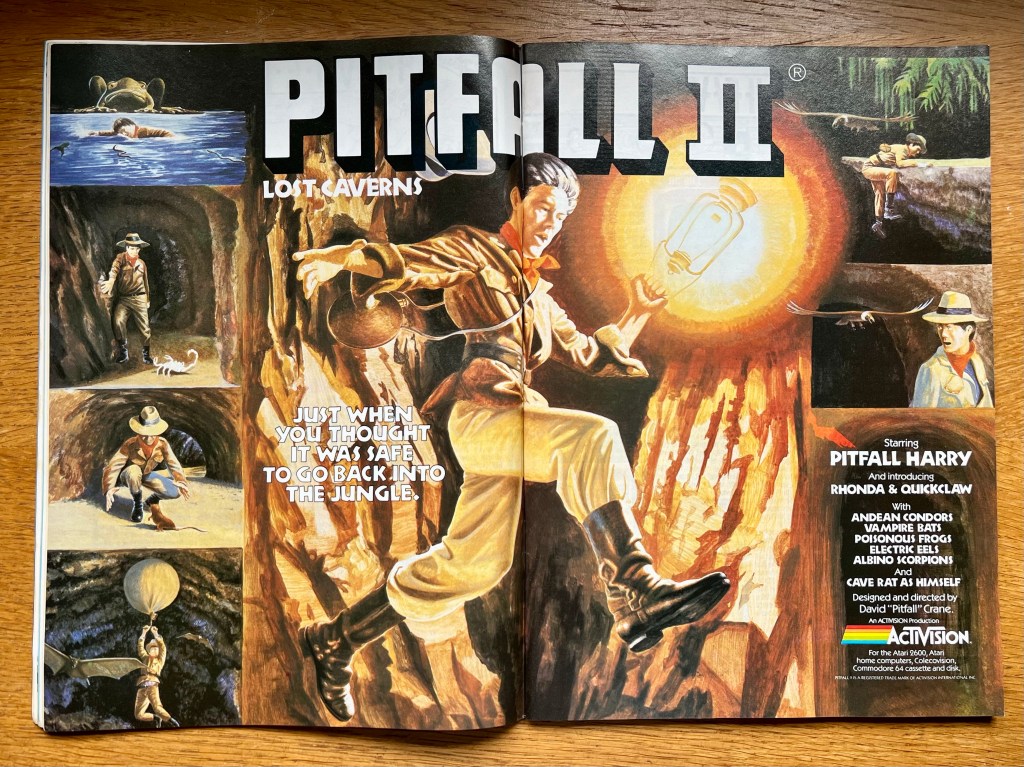
Before we get there, though, there’s a huge double-page advert for Pitfall II which is definitely the most striking advert in the whole magazine! The adverts are always another highlight for me with these, as well as the thrill of remembering seeing all-time favourites for the first time – I’m not such a big fan of Pitfall, so we won’t be seeing that in more detail here any time soon either, but in this issue alone there’s Chuckie Egg, Beach Head, Revenge of the Mutant Camels, Football Manager, Moon Alert, er, Kosmic Kanga and more we’ll come back to! Back to Pitfall II first though, there’s clearly a lot of work gone into this, and even if it’s not all of the highest order in terms of artistry, it’s obvious enough you’re getting Indiana Jones, and what’s not to love about Pitfall Harry swimming past electric eels in front of a giant frog, or floating past a giant bat on a homemade hot-air balloon?
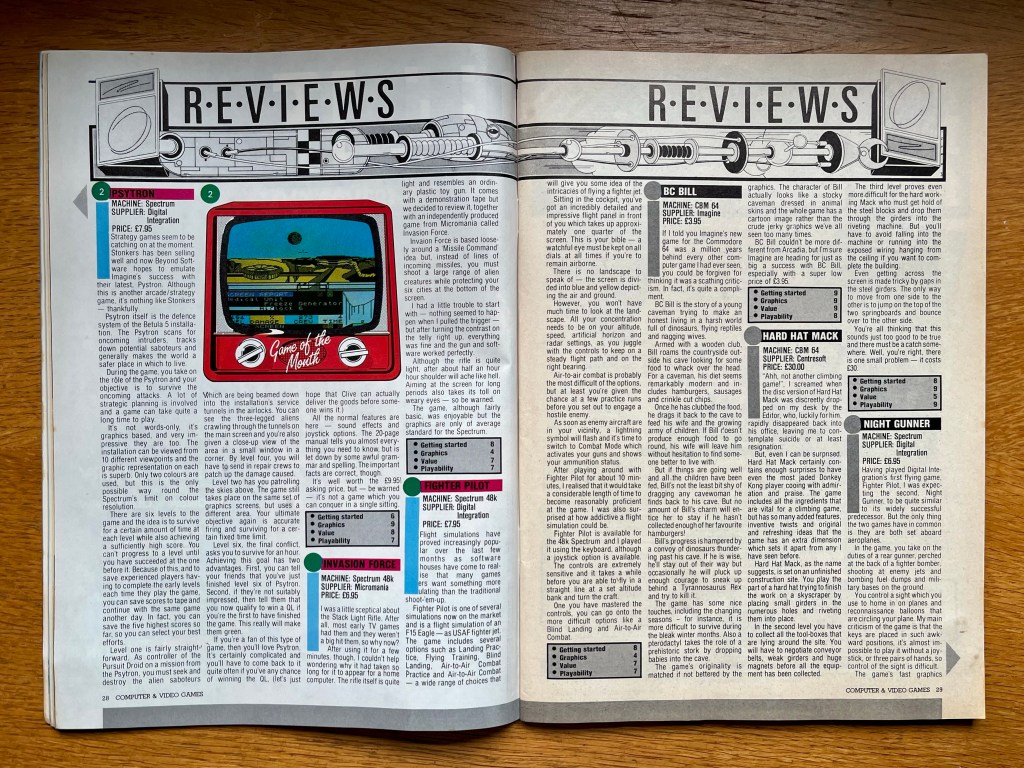
Back to that second Game of the Month then, and it’s another I’ve never heard of, and it’s Psytron for the ZX Spectrum! “All the normal features are here – sound effects and joystick options.” If that’s not game of the month material, I’m not sure what is, but it seems like it’s a sci-fi arcade-strategy game that takes a long time to play – the last of the six levels alone appears to involve surviving an attack for an hour! Despite all the words, and the recommendation that if you’re a fan of this type of game you’ll love this, it doesn’t actually say anywhere what type of game it is beyond arcade-strategy. Whatever that is! What I’m getting is a primitive take on something like Night Trap (yes, you heard me right!) where you’ve got ten different views of your base that you need to monitor for intruders then take (arcade) action. I’m still not getting where the strategy comes in but it seems there’s loads of it, and despite scoring way less than the seminal proto-budget BC Bill for the C64 on the opposite page, it’s apparently very much worth the £9.95 asking price and its Game of the Month accolade. Again, don’t watch this space however pretty it looks though!

Right, another advert, because “last year W.H. Smith sold thousands of Sinclair Spectrums, making us one of the leading stockists in the country and the ideal choice for Spectrum Software.” Including the obligatory extensive choice of educational software! I’d spend forever browsing all the magazines in there, and it was good for books and alright for toys too, but was always a bit of the poor relation compared to the independents or Boots and Woolworths when it came to games. It had everything for the big machines but I seem to remember them being a hassle to buy, with someone having to find the game in a drawer under the display before you paid, and they seemed to cost more as well. Rubbish for VIC-20 too! And a rubbish advert, but just look at those games! Chequered Flag was the first Spectrum game I ever played, and is what sold me on needing one the very first time I ever sat in that mind-blowingly realistic 3D Formula One cockpit! Then we’ve got Jet Set Willy again, a timeless masterpiece in brutal platforming and one of the greats on the system, and there’s more Atic Atac, Ant Attack, Bear Bovver and a game called Speed Duel I’ve never come across before, but on the strength of the company it’s in on this page alone, I have added this one to my big list of games to come back to and look at here in the future, so do watch this space this time!

You’d always get a bunch of type-ins in these mags, and they’d cover every system regardless of popularity – no doubt still drawing us VIC-20 and BBC owners in when the cupboard was bare elsewhere! This month we had space management game Space Academy for the VIC-20, an adventure for the C64 called Castle of Doom, Road Runner (yes, that one) for the Texas, plus Spider Grid on the Dragon, Omelette on the Oric, Missile Command(!) on the BBC and Wonderman on the Spectrum. And if that wasn’t enough, this month we had a really special, cover-worthy listing for the 16K Spectrum too, created by no-less than Matthew Smith of Manic Miner Willy fame! Not only that, but this one is an exclusive listing for an idea that didn’t make it into Jet Set Willy, where you’re trying to make yourself some dinner in the kitchen while avoiding man-eating pizzas! I do love a type-in and this one is up there with the best of them!
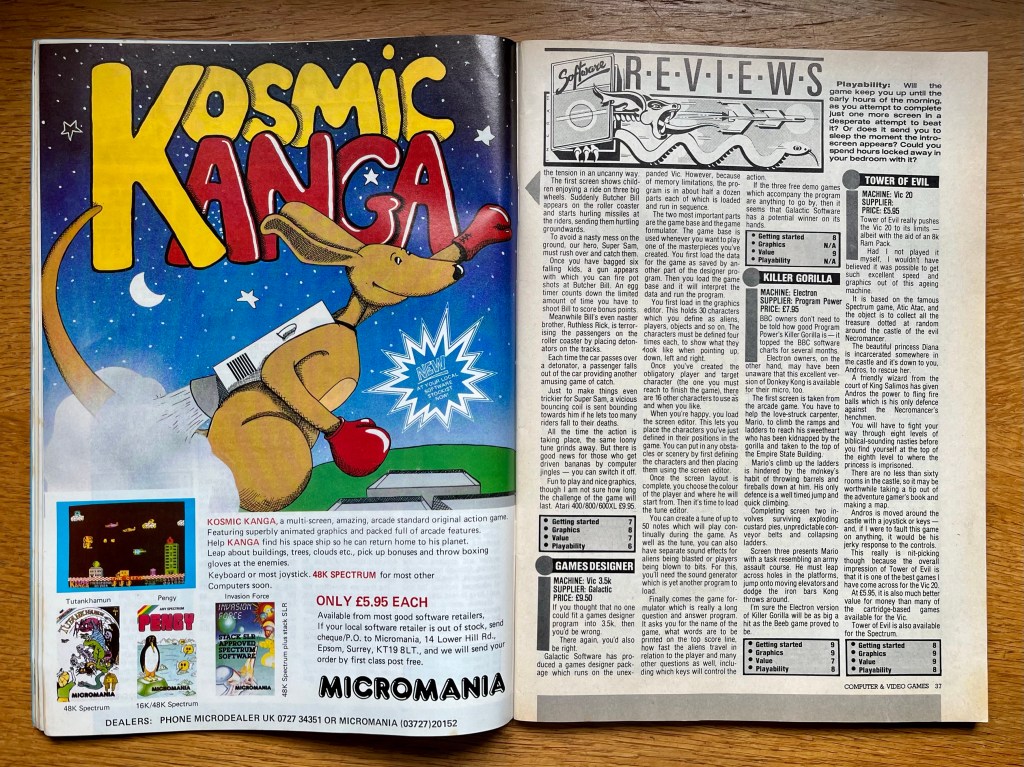
I really could go on and on with this stuff but it’s time we hit that Tower of Evil! Once I could tear my eyes away from the mesmeric Kosmic Kanga on the opposite page, this review jumped out at me for a few reasons… First, it’s the second VIC-20 review on this single page, would you believe? Second, it needs an 8K RAM expansion, and I always felt bad for anyone that had one of those because games were almost always either for the unexpanded (3.5K) VIC-20 or 16K expanded! And third, it’s not only scoring exactly the same as BBC Zaxxon from earlier but is “one of the best games I have come across for the Vic 20” and to top it all off, I’ve never heard of this one either! And with that, I’m going to abandon the C&VG review there so I can make up my own mind…
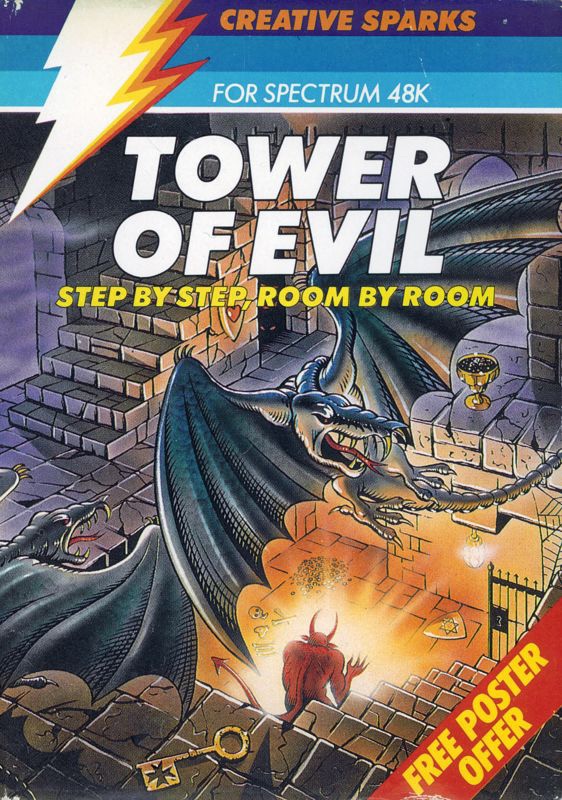
What the review didn’t tell me was that this is from Creative Sparks (Thorn EMI), who also made Submarine Commander, which is one of the best games I ever owned on the machine! Really stands the test of time that one, and it’s still so atmospheric, big in scope and polished too. Bodes well for this title then, which came out in July 1984 on the VIC-20 as well as the Commodore 16 / Plus 4 and the ZX Spectrum, and I guess we might have a look at those versions later but I do need to refer to the Spectrum version quickly now too because I can’t find any trace of VIC-20 instructions, where that version’s are a bit more forthcoming and I assume are similar! The story goes that many years ago, our hero Andros was banished from the court of King Salimos, destined to never return unless he got back the king’s lost treasure, stolen by a wicked necromancer and his minions. To help out with that, his friend the court wizard gave him the power to shoot fireballs out of his fingertips, so with those in hand, literally, he’s journeyed all the way to the Tower of Evil, home of the necromancer, to recover the treasure.
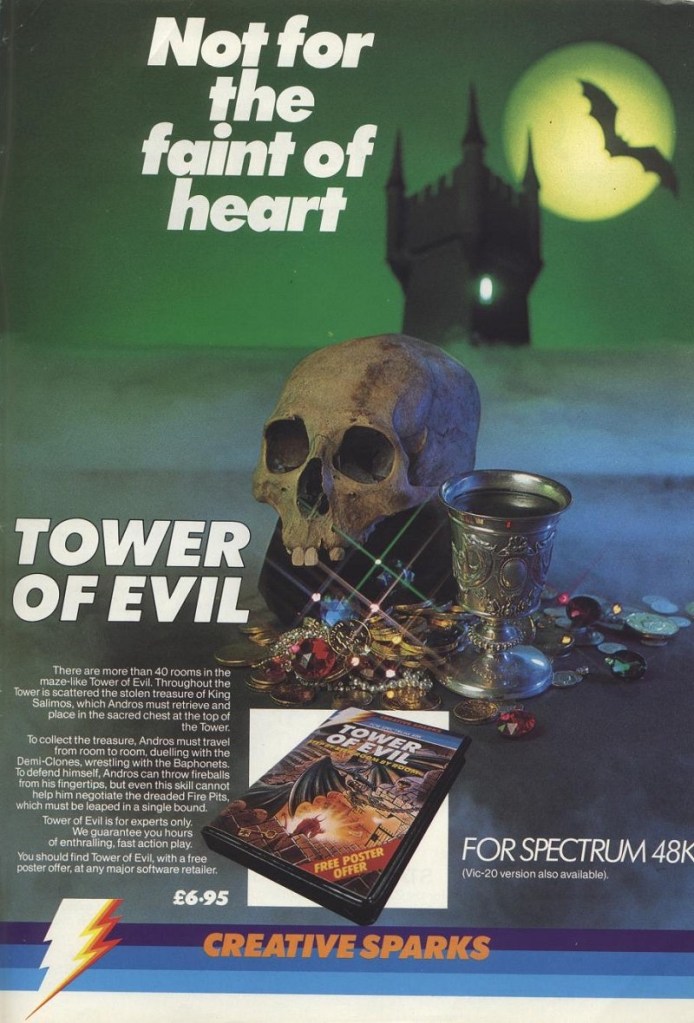
As he travels from room to room (of which there are over forty according to the Spectrum instructions, or sixty according to C&VG) he’ll have to collect nine treasures and find a key to travel to the next floor, avoiding pits of burning coals between each level and the balls of fire being tossed about by the evil Guardian of Fires, and by my reckoning there five floors. That’s not the only evil on the loose though, and along the way you’ll come across Valfors, Xaphans and Baphomets that will enter the room you’re in one at a time at fixed intervals, with a limit on the total number depending on how far you’ve gone. Andros will also need to look out for goblets, which will either make him temporarily invincible if they contain Essence of Wild Volvus, or double his strength for a while if they contain Cigam, whatever that is! To make sure it stays safe, any treasure he finds will need to be deposited in a chest all the way back on level one. Apart from that, you move in eight directions with fire to shoot fireballs in any of those directions for regular rooms or to jump over the fire pits between floors. And obviously I’m making assumptions that all of that applies to the VIC-20 version too, so let’s find out!

One thing that sadly doesn’t apply is the beautiful Spectrum loading screen, although I think it can still work perfectly to set the scene here too! And that’s not the only thing that won’t apply but don’t despair because the first thing you need to know is this game is the VIC-20’s answer to Atic Atac, which, as we’ve already seen, was all the rage in the summer of 1984! And the other thing is it’s fantastic, whether it’s been totally stripped down to the bone or not! The funny thing is though – and partly why I also wanted to run through the full-fat Spectrum version’s instructions for context – less is definitely more with Tower of Evil! The principle is all the same, with you after treasure on each floor, and the key to get to the next, and a goblet if you can because they certainly help, then do it all over again. It’s just one piece of treasure per floor here though, and the key will give you access to a kind of teleporting door thing that you can move back and forth through but there’s really no point most of the time because there’s also no need for the tedious run (and it really is) all the way back to the start of the game every time you want to bank a piece of treasure – just collect and move on towards your end goal.

While it does feel a lot like Atic Atac, it also feels a lot like a twin-stick shooter but without the second stick, and having your fireball strapped to your current direction with a very deliberate and fairly slow rate of fire (unless you find the right goblet that effectively gives you a double-size shot) adds an unexpected tension to every single room. You can’t just wipe out the quickly-materialising mass of enemies willy-nilly – you need to be way more strategic, circling the room and drawing them out to create a gap you can get through, especially when there’s something you need to collect in the room. If not, you can always just make a run for it, but there’s a big risk to that because the enemies have this really annoying habit of materialising in a doorway at the precise second you’re about to run through it! Likewise, you can also exit a door into the next room for exactly the same thing to happen, without warning and without any chance to do anything about it – another of your five lives lost. I have to say this did annoy me way more for my first few games than later when I was anticipating it and firing a pre-emptive fireball at the space in the exit I was aiming for. All the same, this will account for as many deaths as trying to clear the rest of the room, but even that’s temporary because when one dies the next will just respawn!

Overall, the difficulty is set just about right though. While they do get aggressive the further up the tower you travel, there’s never more than six enemies in any room at once, which might be down to hardware limitations but it can get claustrophobic enough with that many, and there is also some time to do your business in a room before too many appear, as well as a bit of respite when you shoot a few before their replacements turn up. Despite their fancy demonic names in the Spectrum instructions, the reality of the enemies is a variety of different shapes, some of which are alien-looking, and there’s some snakes and bats, some pulsating bubble things and the rest just menacing-looking squares on lines and the like! One thing I didn’t like is the floor you’re on being indicated by the type of enemy you’ll find in it on the display at the top of the screen, where you’ll also find current objects found on that floor as well as your score, but why not just say the floor number? Can’t be any harder to program and is way easier than trying to remember what enemy was on what floor!
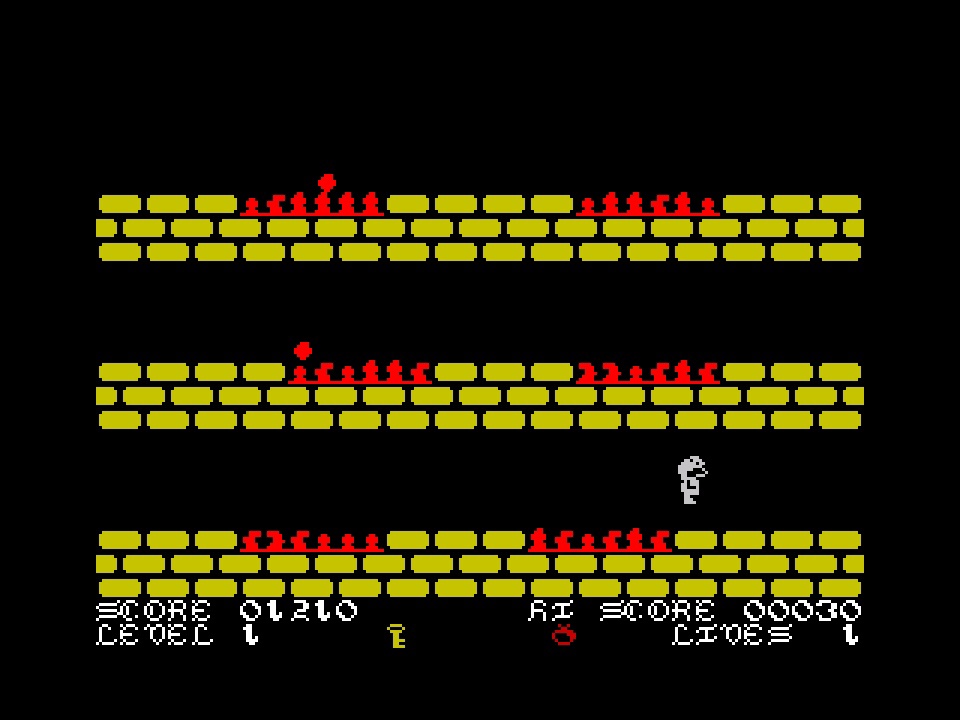
Something I did appreciate, though, was being able to travel directly between levels and not have to negotiate that dreadful fire screen on the Spectrum version! It involves running and jumping over three levels of burning pits stacked on top of each other on the screen, so you’ll start bottom left then emerge from the right side of the screen middle left and so on until you come out top-right. And it would be frustrating enough without having to contend with the fire balls being randomly thrown across each level too! Jet Set Willy this ain’t – not even a type-in version – although what it’s actually trying to be is Hunchback, which we also came across earlier, but ends up being it’s far less enjoyable clone Punchy instead… Also advertised in this very issue of C&VG – it’s got everything! Actually, Punchy is another good example of a game that’s better on the VIC-20 than on the Spectrum, where it’s punishing but vaguely enjoyable on the former while just smash your Kempston joystick nasty on the latter! Anyway, once again, for the VIC-20 version we’re better off without this “bonus” screen on Tower of Evil. I guess though – given this is having a go at being Atic Atac – it needed to do a bit more on the Spectrum where real Atic Atac lives, and they do have another 40K of memory to play with over there too! Because I couldn’t get the C16 / Plus 4 version to work, I might as well quickly finish with the Spectrum one while we’re here – the graphics are a bit bigger and cleaner but not dramatically so, there’s a bit more sound (including a very-Spectrum circa 1984 ditty on the title screen) and obviously there’s a bit more to the game as we’ve seen already, but in terms of minute-to-minute gameplay there’s really not a lot in it. Until you try to climb to the next floor!

Definitely nothing to be jealous of (for once!) as a VIC-20 owner though, and I had a really good time with the more straightforward – and fun as a result – gameplay loop. I think the floor layouts are fixed but everything else moves around every time you play, similar to Atic Atac, so there’s enough variety on top of the challenge to keep you coming back, and I really got a kick out of finally reaching the top floor too, where you’ll soon encounter a big treasure chest that will reward you with a big score once you find the key on that level and bring it back there, and explore a bit further and you’ll find the beautiful missing princess Diana that a quick look back at the C&VG review confirms is your objective in this version. Oh well, it all turned out alright in the end regardless! A quick kiss from her and the game loops all over again, but about two screens in to the bottom level again was as far as I ever got so we’ll never know if it does a Ghouls ‘n Ghosts or just goes on looping forever!

As basic as this thing looks, sounds and plays now, to a connoisseur of the VIC-20 you’ll understand why the C&VG reviewer was so impressed. It’s really captured the essence of what was a very popular game at the time in Atic Atac, and that means it’s also captured its sense of adventure, and that’s a big deal on the VIC-20. Okay, it might be hard to relate to the graphics as being “excellent” nowadays, and I’d say something like Punchy that I just referenced is better looking, but it does still move well with a screen full of stuff, and while it does fully justify C&VG’s lack of a sound score at this point in time, with just a couple of beeps now and then, it all does what it has to to support the gameplay. And that’s where the reviewer was exactly right – it still feels great to play, basic or not, and most importantly it does that way better than the fancier Spectrum version, and while that might not mean a lot to most, to us connoisseurs that can never be underestimated!

